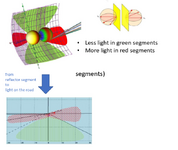There are particular attributes that a LED bulb must possess in order to be as close as possible to having filament equivalence which therefore increases its optical compatibility. Basically this means that there will be a higher number of lamps that will respond well to the LED bulb
if it is designed with certain key features. But even if a "as perfect as can be" LED bulb existed, it still won't be applicable for ALL lamps.
Todays current LED headlight bulb template, which is comprised of two opposing sides of LED chips mounted to a PCB and mounted to an aluminum body, is physically incapable of fully replicating the emission behavior of a filament bulb.
As long as LED bulbs continue to be designed this way, they will NEVER achieve 100% filament equivalence.
The image below compares how a typical LED bulb configuration appears in relation to a filament. The separation between the LED chips, where the PCB and/or aluminum body would reside, is one of the major factors for an improperly focused beam. The larger the separation from the light source reference axis, the worse the beam becomes. The smaller the separation, the better the beam becomes.
Here we see how the filaments emission in the far field behaves in the optics.
And here we see how LED behaves in the same optics. Basically there are surfaces on the reflector that do not receive sufficient light. And these surfaces contribute to the beam. And since many lamps are designed optically different from one another, the portions of the beam that suffer will also be different.
Furthermore, the LED chips being sourced for these bulbs are too big. The emitting surface of the dies exceeds the boundaries of the filament which can lead to glare.
And WORSE of all is the position of the LED chips. This is VERY critical to the focus of the beam. And from my testing, mostly all LED bulbs do not position the array at the correct *optimal* location.


